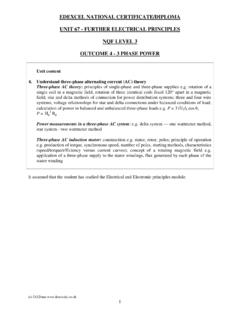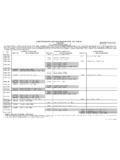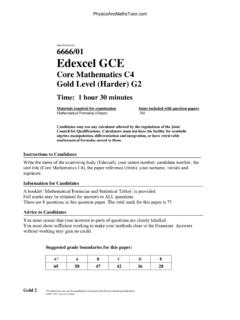Transcription of EDEXCEL NATIONAL CERTIFICATE/DIPLOMA …
1 EDEXCEL NATIONAL CERTIFICATE/DIPLOMA . further mechanical PRINCIPLES AND APPLICATIONS. UNIT 11 - NQF LEVEL 3. OUTCOME 3 - ROTATING SYSTEMS. TUTORIAL 1 - ANGULAR MOTION. CONTENT. Be able to determine the characteristics of rotating systems Rotating systems with uniform angular acceleration: systems simple (such as rotating rim, flywheel, motor armature, pump or turbine rotor), complex (such as systems where combined linear and angular acceleration is present, hoist and vehicle on an inclined track); kinetic parameters angular displacement, angular velocity, angular acceleration, equations for uniform angular motion 2= 1+ t, = 1t + t2, 22 = 12 + 2 , = ( 1+ 2)t.
2 Dynamic parameters radius of gyration, moment of inertia (I = mk2), inertia torque (T = I ), friction torque, application of D'Alembert's principle, mechanical work (W = T ), power (Average Power = W/t, Instantaneous Power = T ), rotational kinetic energy (KE = I 2), application of principle of conservation of energy. Rotating systems with uniform centripetal acceleration: systems simple (such as concentrated mass rotating in a horizontal or vertical plane, vehicle on a hump-backed bridge, aircraft performing a loop), complex (such as centrifugal clutch, vehicle on a curved track);. kinetic parameters expressions for centripetal acceleration (a = 2r, a =v2/r); dynamic parameters expressions for centripetal force (Fc = m 2r, Fc = mv2/r).
3 It is assumed that the student has studied mechanical Principles and Applications Unit 6 and in particular the section on linear motion. 1. 1. REVISION OF LINEAR MOTION. When a body moving at velocity u m/s accelerates uniformly to v m/s in time t the graph is as shown. From this we can deduce that: a = (v - u)/t v = u + at s = t/2 (v + u ). s = ut + at2/2. v2 = u2 + 2as t is time s is the distance moved. u is the initial velocity v is the velocity at time t. a is the uniform acceleration. These equation apply equally to rotating bodies and this is the main area you need to study. 2. ANGULAR MOTION.
4 This work applies to bodies revolving about a point at a fixed radius so the path taken by any point on the body is a circular path. This could apply to wheels of many forms, to vehicles (land, sea and air) going around a curve. ANGLES. Angle has no units since it a ratio of arc length to radius. We use the names REVOLUTION, DEGREE and RADIAN. REVOLUTION. A point on a wheel that rotates one revolution traces out a circle. One revolution is the angle of rotation. This is a bit crude for use in calculations and we need smaller parts of the revolution. DEGREES. Traditionally we divide one revolution into 360 parts and call this a degree with symbol o.
5 1. revolution = 360o The picture shows a circle divided into 360 parts. They are so close they can hardly be seen individually. Even so, a single degree is not accurate enough for many applications so we divide a degree up into smaller parts called minutes. 1o = 60 minutes or 60'. A minute can be divided up into even smaller bits called seconds and 1 minute = 60 seconds or 60". In modern times we use decimals to express angles accurately so you are unlikely to use minutes and seconds. 2. GRADS. In France, they divide the circle up into 400 parts and this is called a Grad. 1 revolution = 400 Grad.
6 This makes a quarter of a circle 100 Grads whereas in degrees it would be 90o. RADIAN. In Engineering and Science, we use another measurement of angle called the Radian. This is defined as the angle created by placing a line of length 1. radius around the edge of the circle as shown. In mathematical words it is the angle subtended by an arc of length one radius. This angle is called the RADIAN. The circumference of a circle is 2 R. It follows that the number of radians that make a complete circle is 2 R. or 2 . R. There are 2 radians in one revolution so 360o = 2 radian. 1 radian = 360/2 = In the following work we will be using degrees and radian so it is very important that you make sure your calculator is set to the units that you are going to use.
7 You might find a button labelled DRG on your calculator. Press this repeatedly until the display shows either D (for degrees) or R. (for Radian) or if you are French, G (for Grad). On other calculators you might have to do this by using the mode button so read your instruction book. Also note that since one revolution is 2 . radian and also 360o we convert degrees into radian as follows. (radian) = degrees x 2 /360 = degrees x /180. ANGULAR VELOCITY . The symbol for angular velocity is the lower case of the Greek letter Omega - . If a body turns at constant speed, the angular velocity is the angle turned in 1 second.
8 The angle turned in t seconds is then: . = t and so rad/s t If the body is speeding up or slowing down we may express the instantaneous angular velocity as the rate of change of angle per second. d . In calculus form we can write . dt In practical cases, angular velocity or speed is usually given in revolutions/second or revolutions/minute. When solving problems we nearly always have to convert this into radians/s. Since a circle (or revolution) is 2 radian we convert rev/s into rad/s by = 2 N. EXAMPLE No. 1. A wheel rotates 200o in 4 seconds. Calculate the following. i. The angle turned in radians?
9 Ii. The angular velocity in rad/s SOLUTION. = (200/180) = rad. = = rad/s 3. SELF ASSESSMENT EXERCISE No. 1. 1. A wheel rotates 5 revolutions in 8 seconds. Calculate the angular velocity in rev/s and rad/s. (Answers rev/s and rad/s). 2. A disc spins at 3000 rev/min. Calculate its angular velocity in rad/s. How many radians has it rotated after seconds? (Answers rad/s and rad). ANGULAR ACCELERATION . Angular acceleration (symbol - alpha) occurs when a wheel speeds up or slows down. It is defined as the rate of change of angular velocity. Since angular velocity is the rate of change of angle we can also say that acceleration is the rate of change of the rate of change of angle.
10 If the wheel changes its velocity by in t seconds, the acceleration is = / t rad/s2. d d 2 . In calculus form we can express this as . dt dt 2. WORKED EXAMPLE No. 2. A disc is spinning at 2 rad/s and it is uniformly accelerated to 6 rad/s in 3 seconds. Calculate the angular acceleration. SOLUTION. = /t = ( 2 - 1)/t = (6 -2)/3 = rad/s2. SELF ASSESSMENT EXERCISE No. 2. 1. A wheel at rest accelerates to 8 rad/s in 2 seconds. Calculate the acceleration. (Answer 4 rad/s2). 2. A flywheel spins at 5000 rev/min and is decelerated uniformly to 2000 rev/min in 12 seconds. Calculate the acceleration in rad/s2.














